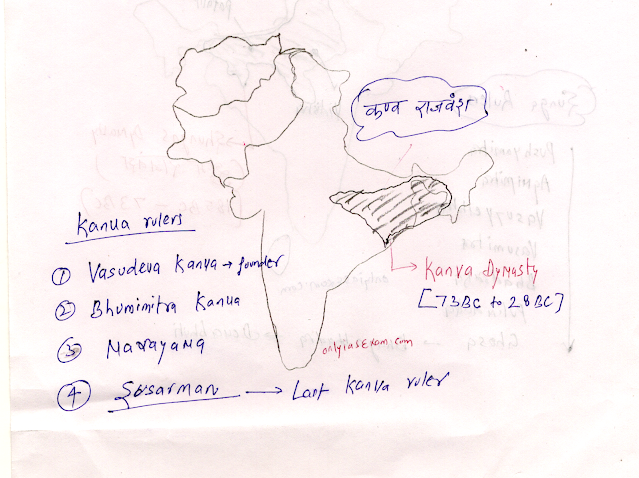Table of Contents:
- About Kanva Dynasty
- The ruler's list of the Kanva dynasty
- Significance and Achievements of the Kanva Dynasty
Notes on Kanva Dynasty ( 73 BC to 28 BC):
The Kanva dynasty was an ancient Indian dynasty that ruled in the northern part of the Indian subcontinent from about 73 BC to 30 BC.
The Kanva dynasty emerged after the decline of the Shunga dynasty and played a significant role in the political landscape of ancient India.
The founder of the Kanva dynasty was Vasudeva Kanva. Vasudeva killed the last Sunga King “ Devabhuti”, he was a minister of Devabhuti.
Kanva rulers belonged to Brahmin.
Kanva Dynasty ruled mostly in present-day Bihar, West Bengal, and Odisha regions.
The capital of the Kanva dynasty was Patliputra.
The rulers of the Kanva dynasty:
The following are the rulers of the Kanva Dynasty:
- Vasudeva Kanva
- Bhumimitra Kanva
- Narayana
- Susarman
Vasudeva Kanva:
Vasudeva Kanva was the founder of the Kanva dynasty. He was a minister in the Shunga administration and seized power after the downfall of the last Sunga King, Devabhuti.
Susarma:
Susarma was the last ruler of the Kanva dynasty. Andhra Satvahana's king ( Simuka) killed the last ruler of the Kanva dynasty.
Significance and achievements of the Kanva dynasty in Ancient Indian history:
The Kanva dynasty was relatively short-lived. The following are some achievements of the Kanva dynasty.
Transitional Period:
The Kanva dynasty emerged as a transitional period between the decline of the Shunga dynasty and the rise of the Satvahana dynasty. This transition witnessed political shifts and regional power struggles, showcasing the dynamic nature of ancient Indian polity.
Patronage of Art and Literature:
The Kanva dynasty continued the legacy of promoting Sanskrit literature, scholars, and poets were encouraged to flourish under their patronage. They also promoted Buddhist art and culture.
You may like also:

ConversionConversion EmoticonEmoticon